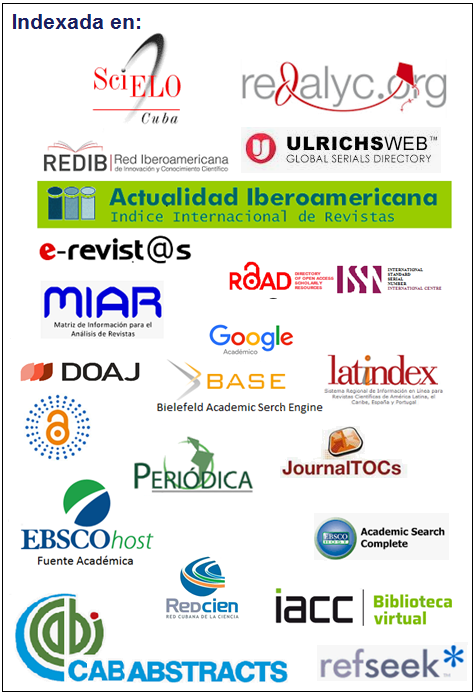Drinking Water Quality Assessment according to Montoya’s in Yamanigüey town
Keywords:
water quality, ICA, Montoya’s methodology, drinking water, Yamanigüey town.Abstract
Water quality indices (ICA) summarize and simplify, in a single numerical value, the quality of the water from a wealth of available information. Montoya's methodology was applied to determine the drinking water quality indexes (ICA) in Yamanigüey town from Moa municipality, Cuba. Water samples were taken at 10 points distributed among the supply sources from the town: Yamanigüey River, the storage tank and local boreholes. According to the applied methodology, the analyzed waters are classified as acceptable when obtaining Water Quality Indexes values between 70 and 84. However, from the bacteriological point of view, they equal or exceed the maximum admissible limit for fecal and total coliforms, mainly in the local boreholes why it is recommended the use of an efficient purification process for its purification and consumption.Downloads
References
Balmaseda-Espinosa, C. y García-Hidalgo, Y. 2014: Índice canadiense de calidad de las aguas para la cuenca del río Naranjo, provincia Las Tunas, Cuba. Revista ciencias técnicas agropecuarias, 23(3): 6. ISSN 2071-0054.
Chiliquinga-Quinapanta, C. A. y Donoso-Cruz, H. E. 2012: Caracterización de la calidad de agua de la microcuenca del río pachanlica de la provincia de tungurahua tomando como base la metodología ICA de Montoya. Escuela Superior Politécnica de Chimborazo.
CITMATEL. 2017: Enfrentamiento al cambio climático en la República de Cuba Tarea Vida.
Crespo-Lambert, M. 2018: Evaluación de la calidad de las aguas de abastecimiento del poblado Yamanigüey. Tesis doctoral. Universidad de Moa.
Fernández-Prada, N. J.; Solano-Ortega, F. y Ramos, G. 2005: Índices de calidad (icas) y de contaminación (icos) del agua de importancia mundial. Capítulo III. En: Índices de calidad (icas) y de contaminación (icos) del agua de importancia mundial. p. 78-80. ISBN 958-33-7810-0.
Fernández-Rodríguez, M. y Guardado-Lacaba, R. M. 2021: Evaluación del índice de calidad del agua (icasup) en el río Cabaña, Moa-Cuba. Minería y Geología, 37(1): 105-119.
García-Hidalgo, Y. y Balmaseda-Espinosa, C. E. 2013: Índice simplificado de gestión de la cuenca del río Naranjo, municipio Majibacoa, provincia Las Tunas. Revista Ciencias Técnicas Agropecuarias, 34(1): 5.
Miravet-Sánchez, B. L.; García-Rivero, A. E.; López-Del Castillo, P.; Alayón-García, G. y Salinas-Chávez, E. 2016: Calidad de las aguas del río ariguanabo según índices físico-químicos y bioindicadores. Ingeniería Hidráulica y Ambiental, 37(2): 108-122. ISSN 16800338.
Nava-Ramírez, C. 2008: Estadísticas del agua en México.
NORMA CUBANA 1021: 2014: Higiene comunal - fuentes de abastecimiento de agua - calidad y protección sanitaria. La Habana. Oficina de Normalización.
NORMA CUBANA 827: 2017: Agua potable - requisitos sanitarios. La Habana. Oficina de Normalización.
Pérez-Castillo, A. G. y Rodríguez, A. 2008: Índice físico químico de la calidad de agua para el manejo de lagunas tropicales de inundación. Revista de Biología tropical, 56(4): 1905-1918.
Sucoshañay-Villalba, D. J.; Gutiérrez-Hernández, J. E.; García-Rivero, A. E.; Ledesma-Acosta, R. y Mira-Vásquez, J. M. 2015: Evaluación de la calidad de las aguas superficiales de la cuenca del río puyo de la amazonia ecuatoriana a partir de un índice integrador (ica_sp). Ciencias de la tierra y el espacio, 16(1729-3790): 225-236.
Torres-Vega, F. J. 2009: Desarrollo y aplicación de un índice de calidad de agua para ríos en Puerto Rico. Tesis doctoral. Universidad de Puerto Rico.
Published
How to Cite
Issue
Section
- Authors retain copyright and guaranteeing the right magazine to be the first publication of the work as licensed under a Creative Commons Attribution-NonCommercial that allows others to share the work with an acknowledgment of the work's authorship and initial publication in this journal.
- Authors may establish separate supplemental agreements for the exclusive distribution version of the work published in the journal (eg, place it in an institutional repository or publish it in a book), with an acknowledgment of its initial publication in this journal.
- Authors are allowed and recommended to disseminate their work through the Internet (e.g., in institutional telematic archives or on their websites) before and during the submission process, which can produce interesting exchanges and increase citations of the published work. (See The effect of open access)



